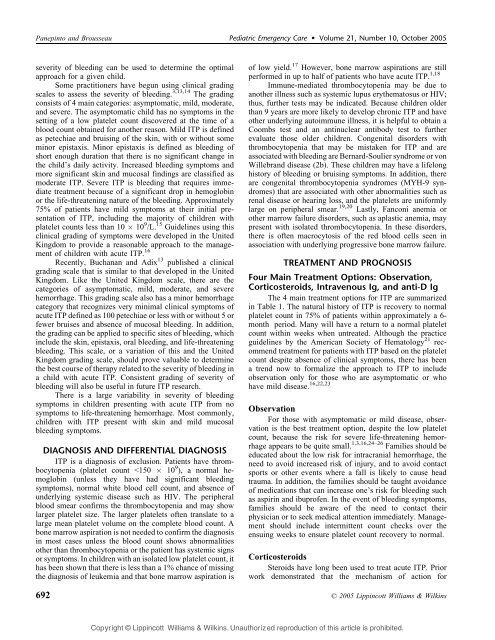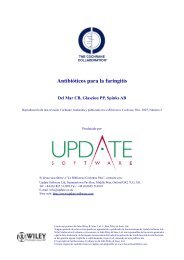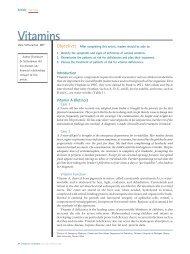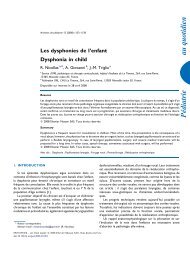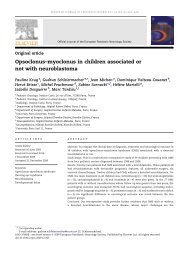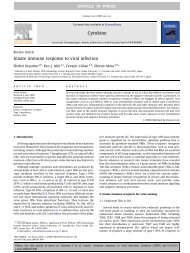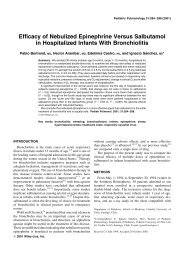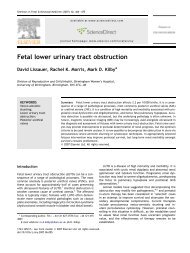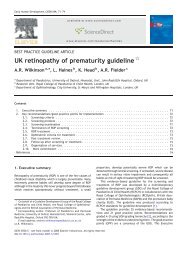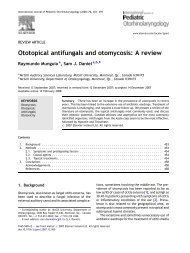Acute Idiopathic Thrombocytopenic Purpura of Childhood ... - sepeap
Acute Idiopathic Thrombocytopenic Purpura of Childhood ... - sepeap
Acute Idiopathic Thrombocytopenic Purpura of Childhood ... - sepeap
Create successful ePaper yourself
Turn your PDF publications into a flip-book with our unique Google optimized e-Paper software.
Panepinto and Brousseau Pediatric Emergency Care Volume 21, Number 10, October 2005<br />
severity <strong>of</strong> bleeding can be used to determine the optimal<br />
approach for a given child.<br />
Some practitioners have begun using clinical grading<br />
scales to assess the severity <strong>of</strong> bleeding. 3,13,14 The grading<br />
consists <strong>of</strong> 4 main categories: asymptomatic, mild, moderate,<br />
and severe. The asymptomatic child has no symptoms in the<br />
setting <strong>of</strong> a low platelet count discovered at the time <strong>of</strong> a<br />
blood count obtained for another reason. Mild ITP is defined<br />
as petechiae and bruising <strong>of</strong> the skin, with or without some<br />
minor epistaxis. Minor epistaxis is defined as bleeding <strong>of</strong><br />
short enough duration that there is no significant change in<br />
the child’s daily activity. Increased bleeding symptoms and<br />
more significant skin and mucosal findings are classified as<br />
moderate ITP. Severe ITP is bleeding that requires immediate<br />
treatment because <strong>of</strong> a significant drop in hemoglobin<br />
or the life-threatening nature <strong>of</strong> the bleeding. Approximately<br />
75% <strong>of</strong> patients have mild symptoms at their initial presentation<br />
<strong>of</strong> ITP, including the majority <strong>of</strong> children with<br />
platelet counts less than 10 10 9 /L. 15 Guidelines using this<br />
clinical grading <strong>of</strong> symptoms were developed in the United<br />
Kingdom to provide a reasonable approach to the management<br />
<strong>of</strong> children with acute ITP. 16<br />
Recently, Buchanan and Adix 13 published a clinical<br />
grading scale that is similar to that developed in the United<br />
Kingdom. Like the United Kingdom scale, there are the<br />
categories <strong>of</strong> asymptomatic, mild, moderate, and severe<br />
hemorrhage. This grading scale also has a minor hemorrhage<br />
category that recognizes very minimal clinical symptoms <strong>of</strong><br />
acute ITP defined as 100 petechiae or less with or without 5 or<br />
fewer bruises and absence <strong>of</strong> mucosal bleeding. In addition,<br />
the grading can be applied to specific sites <strong>of</strong> bleeding, which<br />
include the skin, epistaxis, oral bleeding, and life-threatening<br />
bleeding. This scale, or a variation <strong>of</strong> this and the United<br />
Kingdom grading scale, should prove valuable to determine<br />
the best course <strong>of</strong> therapy related to the severity <strong>of</strong> bleeding in<br />
a child with acute ITP. Consistent grading <strong>of</strong> severity <strong>of</strong><br />
bleeding will also be useful in future ITP research.<br />
There is a large variability in severity <strong>of</strong> bleeding<br />
symptoms in children presenting with acute ITP from no<br />
symptoms to life-threatening hemorrhage. Most commonly,<br />
children with ITP present with skin and mild mucosal<br />
bleeding symptoms.<br />
DIAGNOSIS AND DIFFERENTIAL DIAGNOSIS<br />
ITP is a diagnosis <strong>of</strong> exclusion. Patients have thrombocytopenia<br />
(platelet count


